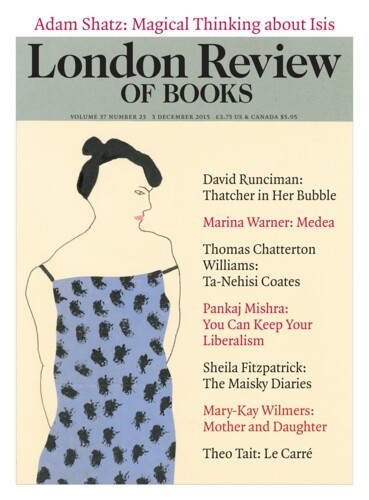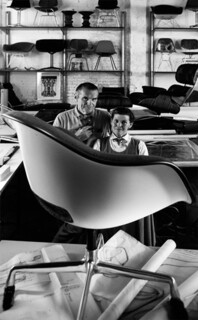‘This is a film about toy trains. These are real toys – not scale models. That doesn’t mean that toys are good and scale models are bad – but they are different.’ To most people, who have never thought of making a moral distinction between toys and scale models, Charles Eames’s schoolmasterly voiceover at the beginning of Toccata for Toy Trains (1957), sets off a chain of ideas. Real toys, model toys, toy toys, toy models, real models, each a slightly different concept, reverberate in the mind like one of Charles and Ray Eames’s own designs. Husband and wife, the Eameses were architects and furniture designers, notably of the plywood and leather armchair and ottoman that has become a classic if not a cliché of the modernist interior and the ubiquitous moulded plastic stacking chair. In a famous photograph they are shown spreadeagled and holding hands under the components of one of the chairs. Although reason dictates that they must be lying on the floor with the camera overhead, it is hard not to read it as if they were stapled halfway up a wall, straining to jump down. The Barbican’s capaciously enjoyable exhibition (until 14 February) hums with that same optimistic vitality.
The Eameses’ many short films were, Charles said, ‘attempts to get across an idea’. Toy Trains illustrates several that were central to their practice: a preoccupation with scale, ‘how large – and small – our environment is’, the power of playful thinking and an admiration for the ‘direct and unembarrassed’. The 14-minute sequence unfolds a landscape of toy houses, stations, countryside and passengers, moving as if by magic. The strings, fingers and winding keys that must propel them are never seen. In everything they did, the Eameses aimed for the effect of ease or, as Charles put it, ‘don’t let the blood show.’
They met at the Cranbrook Academy of Art in Bloomfield Hills, Michigan in 1940 where Ray Kaiser, who trained as a painter, had gone to ‘concentrate on crafts’ and Charles Eames was head of Experimental Design. He was five years older than her and already married, but within a year he was divorced. He and Ray married a month later, their partnership lasting until his death in 1978. Although Charles was usually the spokesman, it was an intricately symbiotic relationship. Interviewing him in 1977 for the American Scholar, Owen Gingerich opened the conversation by remembering how, when he and Eames were at Arlanda Airport in Sweden, Eames had looked round and said: ‘These are all my chairs.’ To which Eames replies: ‘I probably said “These are all our chairs.”’ ‘Never mind,’ Gingerich presses on, but Eames insists: ‘It’s unlike me to say “my chairs”.’
Often referred to as modernists, the Eameses disliked ‘isms’ and boasted of not being ‘ists’ of any sort, but their roots lay in the modernism of the Bauhaus and Scandinavia. Warmer and more flexible than doctrinaire Corbusianism, it came to them through the Finnish architect Eliel Saarinen, who taught at Cranbrook. In 1941, with a loan from Saarinen, the Eameses moved to California into a flat by Richard Neutra, where they began experimenting with moulded plywood and set up the Plyformed Wood Company. Among their first clients was the US navy, for which they designed wooden splints for injured servicemen. These were organic forms that worked with the body, protecting wounds which metal splints would aggravate. Hung on the wall, they look like something by Hans Arp.
In 1949 they moved into their own home, which began life in a project run by Arts & Architecture magazine as Case Study House No. 8. The house was both subject and setting for the rest of their lives. Often filmed, it was furnished with a mixture of their own work and objects found, collected or given: toys, masks, shells. The big windows and bright, Mondrian-coloured wall panels make plain a debt to Gerrit Rietveld, but theirs was never the neutron bomb school of modernism, in which all signs of human life are obliterated in favour of clear surfaces and spaces designed only to be photographed. The house exudes abundance and particularity and the films show it changing and wearing with age. The Eameses believed that a house should be ‘a pleasant place to be in’, a simple concept that is unhappily alien to many architects of any school.
They also likened the role of the architect to that of a host for whom the client is a guest, and theirs was a hospitable house. Their many visitors included at various times Billy Wilder, a party of fifty nuns and Tony Benn, whose thank-you letter in the form of a limerick appears in the exhibition. Their entertaining style fell somewhere between dinner party and performance art, masks might be involved, candles were pre-burned to exact heights. But the self-consciousness seems not to have inhibited conversation; they preferred small gatherings to big parties. This was what became the Californian dream, a life of art, relaxed sophistication and dappled sunshine, and it was a vision the Eameses helped to create and propagate. It was not what they found when they went to Los Angeles, attracted chiefly by the remoteness of the ‘rundown beach community’.
The gallery at the Barbican is not always a successful space, the bays and levels can seem disjointed, but the Eameses with their many facets fit it well and make it if not sing, at least reverberate. The exhibition is full of twangling instruments, none more pleasing than the two-storey tower of xylophone keys the Eameses built in their office. When a ball is dropped in at the top the keys are arranged so that it plays a tune as it bounces to the bottom. Disavowing an attempt to document the whole of their vast oeuvre, the exhibition and accompanying book are imaginatively rich explorations in the spirit of their subjects. The show includes drawings, scale models, films and also G.E.M. Originally entitled Excellence, G.E.M. (Government, Education and Management) is a three-screen slide show of 1967 in which a succession of triple images invite the viewer to see numbers, mouldings, houses, balloons as rhyming shapes, to consider again the large and the small, see a freeway from the air, or snow on the hand of a statue. The Eameses don’t give you long to get each point and the carousel projectors, period pieces now themselves, set up their own counterpoint as they clack smartly round.
The first showing of G.E.M. in 1967 was hosted by IBM, which became one of the Eameses’ major clients, and they made several films about computers, intended to demystify but not debunk the technology whose potential they were quick to grasp. In 1977 they made one of their best-known, Powers of Ten, which revisits questions of micro and macrocosm. Starting with a man and woman picnicking in Chicago, a succession of images pulls back at intervals of the power of ten, up to a hundred million light years from Earth and then returns on the same principle to the ground and on into the man’s hand, into the structure of cells, then atoms. The sequence was taken as a model by Google for its Earth maps but the Eameses didn’t use satellite pictures. Included in the exhibition is the exquisitely detailed collage they made for 103 where, at one kilometre high, ‘plan of city begins to show.’ The collage is an example of its own theme, vastness in miniature.
The Eameses were famous in their lifetime among architects and designers but today they are more widely known. Their eclecticism and their philosophy perhaps sit better now that the binary ‘isms’ of the Cold War era have faded and new anxieties have taken their place. Charles’s notes for Powers of Ten are set out in nine points. The seventh remarks that ‘it is interesting that most of the images in the last part of the film are of information that can be gathered by satellite’ but, as the eighth point says, ‘this information – which is absolutely necessary to guard the health of our earth – is the same information that nations keep as secrets.’ Point nine suggests that ‘what is most interesting is that the governments of the world will have to choose between their secrets and their planet.’ Point ten is left to the future.
Send Letters To:
The Editor
London Review of Books,
28 Little Russell Street
London, WC1A 2HN
letters@lrb.co.uk
Please include name, address, and a telephone number.


